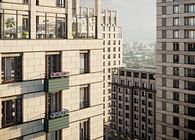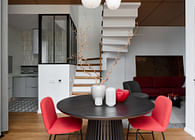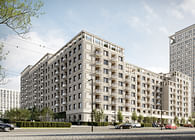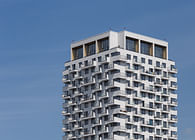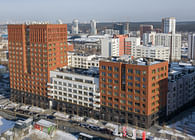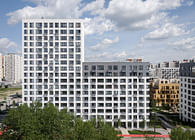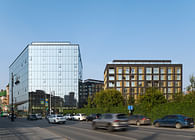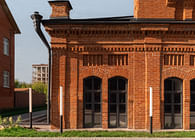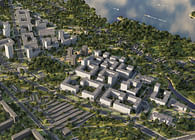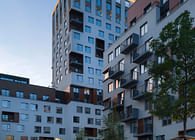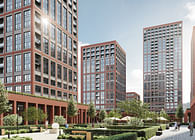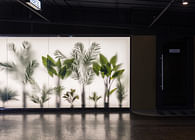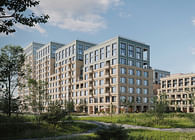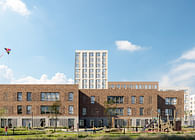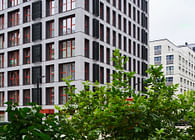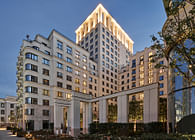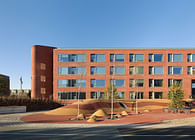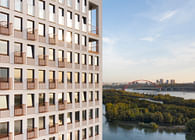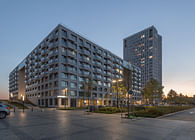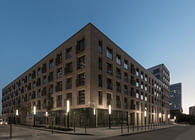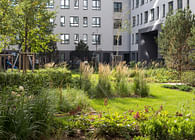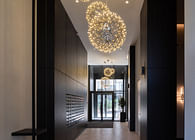
Located in the neighbourhood of a former industrial park, Depot is a new housing estate in Yekaterinburg. With its history linked to railway development in the Urals, the area saw the first marshalling yard launched in 1930, which grew into a major transport hub by the early 1950s. A large-scale tramway and trolleybus repair shop, which serviced the country’s famed Tatra T-3 wagons, opened here in mid 20th century. In the early 2000s, the plant was closed, and the area fell into disuse.
The industrial character of the Staraya Sortirovka, as the area is locally known, affected its development. In the Soviet era, the estate accommodated houses for workers and gained new infrastructure. Shops, transport stations, polyclinics, kindergartens, schools, shopping malls, and parks are all located within walking distance: hence, the district’s appeal and its need for a makeover. Brusnika started its redevelopment project in 2022.
The masterplan by Brusnika.Design turns the water landscape into the project’s major attractor with seven mid-rise blocks linked together by a pedestrian avenue opening onto the riverfront. The banks and the bed of the Olkhovka river, which flows in the north of the plot, will be landscaped to embed an element of nature into the densely packed cityscape. Conceived as complementary water features, the estate will house a fountain in the central square and a system of rain gardens. The rain gardens will filter storm runoff from house roofs and channel it to the river, thus sustaining it.
The orthogonal grid of streets in Depot goes along with the original structure of the quarter. The avenue, hosting a square and a new kindergarten, traverses the estate from north to south, with quiet neighbouring lanes heading west and east. Roads, sidewalks, and adjoining cycling lanes are all on the same level and only differ in the surfacing. Pedestrians enjoy convenient navigation, while driving is limited to the roads contouring the estate. This arrangement references the Eixample district in Barcelona, where traffic is channeled along the outline of super quarters, comprising several blocks.
True to human-scale principles, the architects opted for closed 8 to 9-storey blocks with 16 to 17-storey towers as spatial dominants, and 6-metre pedestrian arches flooding the courtyard with sunlight. Accented sections of bright composite panels complement light-coloured stucco facades. HPL panels finishing courtyard porches and wooden canopies covering terraces evoke a cosy atmosphere. Concise and austere in style, the architecture is by no means sterile, which is visually pleasing in the grey and unappealing late autumn and early spring in the Urals. Street landscaping promotes diversity with species of willow, linden tree, several cultivars of apple trees, spiraea, potentilla, and dogwood. The courtyards planted with birches, lindens, bird cherries, ninebarks, and cotoneasters follow suit.
A functional green axis of the project, the central avenue traverses the built-up area combining the entrance and inner squares, a small linear park, and the street pocket park into a uniform system of diverse spaces. The avenue features playgrounds and recreational zones, and summer cafes. It is open to the general public, while the courtyards inside the housing blocks are private and cosy, intended for leisure and relaxation. Lush green courtyards are complete with toddler playgrounds, lounges, picnic and workout zones, and lawns for games and recreation. Courtyard design is inspired by patchwork — a type of needlework, where separate pieces create a well-balanced composition. This principle is applied while joining the surfacing and different zones inside the project.
The Depot playgrounds have been designed in line with the 2018 research conducted in collaboration with AFA. It revealed eight activities children are willing to do in the courtyard. Some of them, such as play, communication, and movement, seem obvious, while risk and conflict are somewhat unconventional. Based on psychologists’ guidelines, playground elements are wooden, with sand and pebbles as natural fill materials. The courtyards also house multifunctional pergolas having recreational zones, a small co-working space, a container to grow micro greens, and a summer kitchen complete with a worktop and a sink. All the underground area of the houses is utilised for parking, equipped with storerooms and places to keep prams, bikes, sledges, and steerable sleds.
Depot estate serves as a practical example of an industrial park renovation, promoting a local community and new types of public spaces. The project is to be completed by 2030.
Status: Under Construction
Location: Yekaterinburg, RU
Firm Role: Architecture, landscaping, interiors
Additional Credits: Volumetric data
Total area: 7.9 ha
Plot area: 5.7 ha
Built-up area: 2.8 ha
Residential premises: 160500 m2
Commercial premises: 13300 m2
Parking: 9400 m2
Storerooms: 5100 m2
Playgrounds: 2400 m2
Sports grounds: 2050 m2
Kindergarten: 294 places
Implementation deadlines
Design: 2021-2022
Completion: 2022-2030






